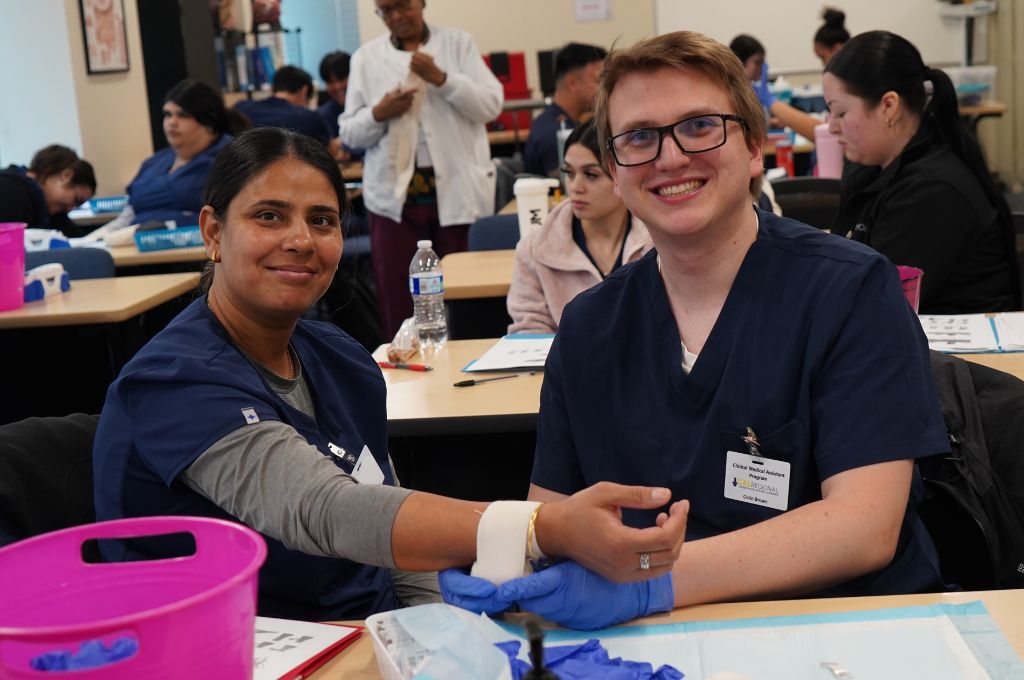Table of Contents
At 26, Jasmine was stuck. She’d spent years in the service industry, on her feet, juggling shifts, craving something more fulfilling. One day, Jasmine took her grandmother to a routine doctor’s appointment. She noticed a calm, focused professional guiding patients through the intake process, taking their vitals, assisting the doctor, and reassuring anxious visitors. Curious, Jasmine looked up the medical assistant job description that night and instantly felt drawn in.
That moment shifted everything. A quick Google search for medical assistant programs near me revealed a fast-growing field with flexible training options and an opportunity to make a real difference in people’s lives. Within a few months, Jasmine ditched her unpredictable server job and was working in a local clinic, certified and confident in her new role.
Suppose you’re exploring a new path or just starting your career. In that case, this guide breaks down the medical assistant job description, the skills you’ll need, salary expectations, certification options, and how to take your first steps.
Key Takeaways
- Training is quick and flexible: Most medical assistant programs can be completed in under a year, with accelerated options available in as little as 8 weeks.
- Medical assistants play a vital role in care: They support both clinical and administrative functions to keep healthcare facilities running smoothly.
- Job duties are diverse and hands-on: From taking vitals and assisting with procedures to managing patient records and scheduling appointments.
- Certification enhances job prospects: Most employers prefer certified medical assistants, and many programs include exam prep and externships.
- There’s room to grow in healthcare: Many medical assistants advance into roles like nurse, physician assistant, or specialist with further training.
Want To Learn More?
What Is a Medical Assistant?
A medical assistant supports doctors, nurses, and healthcare teams in healthcare settings like clinics, urgent care centers, and specialist offices. They’re the friendly faces who greet you at the front desk, the steady hands that take your vitals, and the calm presence beside the doctor during exams.
The role blends patient care with administrative tasks. These responsibilities are at the heart of the medical assistant job description, which includes both clinical and front-office duties. Depending on your training, you may specialize in one area or do a little of both.
There are two main tracks:
- Clinical Medical Assistant: Focused on direct patient care like taking vitals, assisting with exams, drawing blood, and prepping patients. These clinical responsibilities form a core part of the medical assistant job description across most healthcare settings.
- Administrative Medical Assistant: Manages the front office, handling tasks such as scheduling, processing insurance claims, maintaining medical records, and communicating with patients. For those who prefer organization and patient communication, this side of the medical assistant job description can be a perfect fit.
The Clinical Medical Assistant Program, administered by CALRegional in partnership with local schools, focuses primarily on clinical responsibilities while also providing foundational training in administrative tasks.
Medical Assistant Job Description: Core Skills & Duties
Before committing to this path, it’s essential to understand the day-to-day responsibilities of a medical assistant. While some spend more time at a desk, others are more physically active. One moment, you might be calming a nervous patient, and the next, you might be entering lab results or prepping a room for a minor procedure.
Below are the typical responsibilities that fall in the medical assistant job description:
Clinical Duties:
- Measure vital signs (heart rate, blood pressure, etc.)
- Assist physicians with physical exams or minor procedures
- Administer injections or medications (under supervision)
- Collect lab samples (blood, urine)
- Sanitize instruments and prep exam rooms
- Provide patient education and follow-up instructions
Administrative Duties:
- Schedule appointments and coordinate referrals
- Manage electronic health records (EHR)
- Greet and check in patients
- Process billing and insurance paperwork
- Handle phone calls and appointment reminders
You’re often the first and last face a patient sees, so professionalism, warmth, and attention to detail are must-have traits in either setting.
Read more: A Day in the Life of a CMA

Why Medical Assistants Are in High Demand
Medical assistants are essential in keeping clinics and practices running smoothly. According to the Occupational Outlook Handbook, employment for medical assistants is growing much faster than the average for all occupations. About 120,000 openings for medical assistants are projected each year.
Healthcare employers are expanding, outpatient care is growing, and administrative workloads are increasing. This is creating a constant demand for qualified, certified MAs, especially those trained in both clinical and administrative tasks.
How to Become a Medical Assistant
This career path is ideal for those who want to get started quickly! It doesn’t require a four-year degree and offers flexible training options. Here’s how to get started.
1. Enroll in a Training Program
Start by searching for medical assistant certification near me. Traditional programs often span 9–12 months, but CALRegional-administered programs allow you to complete them in just 8 weeks.
You’ll study topics like:
- Medical terminology
- Anatomy and physiology
- Clinical procedures
- Billing and coding
- Medical law and ethics
2. Complete an Externship
Hands-on learning is a key part of quality programs. When researching options for medical assistant schools, ensure that an externship is included in their program. A typical externship places you in a real clinic or healthcare setting, allowing you to apply your skills under the supervision of a professional.
The Clinical Medical Assistant Program, administered by CALRegional, includes guaranteed placement in an externship at the end of the course. This valuable experience helps students get their foot in the door faster and prepares them for the job.
Read more: Answering Our Top 10 Externship Questions
3. Earn Your Certification
Certification is not always legally required, but employers overwhelmingly prefer it. Additionally, it can directly impact your pay and job opportunities. It also validates your training and ensures you meet the standards outlined in the medical assistant job description used by most employers.
Here are common credentials:
- Clinical Medical Assistant Certification (CMAC)
- Certified Clinical Medical Assistant (CCMA)
- Registered Medical Assistant (RMA)
- Certified Medical Administrative Assistant (CMAA)
Look for a certified medical assistant certification that aligns with your interests, salary requirements, and advancement opportunities. Usually, the certification exams are only available to medical assistants who have completed a training program. The medical assistant program administered by CALRegional includes the CMAC certification exam.
Read more: 6 Things to Look For in Medical Assistant Programs
Want To Learn More?
How Much Do Medical Assistants Make?
Salaries vary depending on certification, work experience, and geographic location. One of the main draws of this career path is the long-term earning potential and career advancement opportunities. You can start earning in well under a year and increase your salary over time.
- National Median Salary: $47,262/year
- Top Earners: $62,686+
- Hourly Range: $15.30–$26.92
Here’s a quick breakdown of average salaries by state:
- California: $52,941/year
- Texas: $40,618/year
- Florida: $43,044/year
- Arizona Average Salary: $46,348/year
*Salary info from Indeed as of April 2025.
Where Do Medical Assistants Work?
As a medical assistant, you’ll likely work full-time. Some work evening, weekend, or holiday shifts in medical facilities that are open 24 hours a day. According to the Occupational Outlook Handbook, here are the largest employers of medical assistants:
- Physician offices 56%
- Hospitals 16%
- Outpatient care centers 9%
- Speciality clinics (Chiropractic, podiatry, etc) 8%
Read more: 6 Places Medical Assistants Can Work

Benefits of Becoming a Medical Assistant
If you’re looking for a fast, practical path into healthcare, medical assisting offers one of the most accessible and rewarding entry points. Whether you’re just starting or considering a career change, this role provides a unique blend of patient interaction, hands-on skills, and long-term growth potential.
Here are some of the key benefits that make becoming a medical assistant an excellent career move:
Quick Entry
Most training programs can be completed in under a year, and some accelerated options, as short as 8 weeks, allow you to jump into the workforce quickly. That means you can start earning and gaining real-world experience while others are still deep in multi-year degree programs. It’s ideal for those who want a fast track to a meaningful career.
Stable & Growing Career
Healthcare is one of the most recession-proof industries. For example, during the COVID-19 pandemic, while many sectors faced layoffs and uncertainty, healthcare workers remained essential, and the demand for medical staff surged. As the population continues to age and access to healthcare expands, medical assistants are expected to stay in high demand for years to come.
Versatile Work Settings
As a medical assistant, you’re not limited to one type of environment. From pediatric clinics to orthopedic offices, urgent care centers to dermatology practices, there is a wide range of specialties and work cultures to explore. You can find a setting that matches your personality, schedule needs, or clinical interests.
Read more: Exploring Medical Assistant Specialties
Great for Career Changers
Whether you’re coming from retail, food service, or any other field, medical assisting offers a low barrier to entry and a welcoming path for adult learners. You don’t need prior healthcare experience, and many programs are designed with flexible schedules to accommodate working adults or parents.
Stepping Stone into Healthcare
Many medical assistants use the role as a launchpad into other healthcare careers. The skills outlined in a typical medical assistant job description also translate well into more advanced healthcare roles down the line. The experience you gain in both patient care and administrative functions provides a strong foundation if you later decide to pursue nursing (RN/LVN), physician assistant (PA) programs, or other clinical specialties like radiology, surgical tech, or healthcare administration.
FAQ
A medical assistant supports healthcare providers with both clinical and administrative duties in settings like clinics and doctors’ offices. They might take vital signs, assist with procedures, schedule appointments, and manage patient records.
According to Indeed, as of April 2025, medical assistants earn between $35,641 and $62,744 per year, depending on their location, certification, and specialization.
Yes. Many schools offer medical assistant certification online, often with in-person labs or externships required for hands-on practice. The CMA program administered by CALRegional is a hybrid course–half online and half in person.
Clinical MAs focus primarily on patient care, such as taking vitals, drawing blood, and assisting with exams. Administrative MAs manage front-office tasks such as billing, scheduling, and insurance verification.
Conclusion: Join One of Healthcare’s Most In-Demand Roles
Becoming a medical assistant can lead to a fulfilling, respected, and stable career without years of schooling or massive tuition bills. Whether you’re just out of school or changing careers like Jasmine, the medical assistant job description paints a picture of a career rooted in purpose and growth.
If you’d like to learn more before enrolling, join one of CALRegional’s weekly online info sessions.

